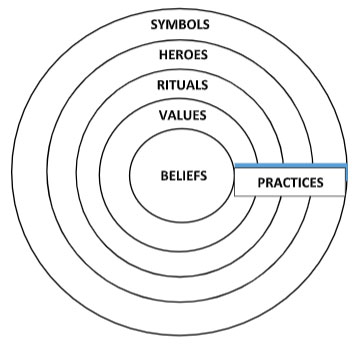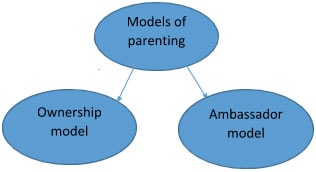Definitions
Culture refers to the cumulative deposit of knowledge, experience, beliefs, values, attitudes meaning, hierarchies, religion, notion of time, roles, spatial relation, concepts of the universe, and material objects and possessions acquired by a group of people in the course of generation through individual and group striving
Manifestation of culture
Cultural differences manifest themselves in different ways and differing levels of depth. Symbols represent the most superficial and value the deepest manifestation of culture, and belief is the core element in manifestation of culture, with heroes and rituals in between.
- Symbols are words, gestures, pictures, or objects that carry a particular meaning which is only recognized by those who share a particular culture. New symbols easily develop, old ones disappear .Symbols from one particular group are regularly copied by others .This is why symbols represent the outer most layer of the culture
- Heroes are persons, past or present, real or fictitious, who poses characteristics that are highly prized in a culture. They also serve as models of behavior
- Rituals are collective activities ,sometimes superfluous in reaching desired objectives but are considered as socially essential .They are therefore carried out most of the time for their own sake (ways of greetings, paying respect to others, religious and social ceremonies,etc)
- The cure of a culture is formed by values. They are broad tendencies for preference of certain state of affairs to others (good-evil, right-wrong, natural-unnatural).Many values remain unconscious to those who hold them, therefore they often cannot be discussed, nor they can be directly observed by others. Values can only be inferred from the way people act under different circumstances
- According to Kwast, the values are not decided arbitrarily but stem from ‘beliefs’. He finds out that certain beliefs (operating beliefs) greatly influence the values and behavior, whereas certain beliefs (theoretical beliefs) have very less practical impact on values and behavior. Hence, certain people may have a different set of beliefs but behave in a similar manner, and vice versa.
- Symbols, heroes, rituals are the tangible or visual aspects of the practice of a culture. The true cultural meaning of the practices is intangible, this is revealed only when the practices are interpreted by the insiders.

Layers of Culture
People even within the same culture carry several layers of mental programming within themselves. Different layers of culture exist at the following levels:
- The national level: Associated with the nation as a whole
- The regional level: associated with ethnic, linguistic, or religious differences that exist within a nation
- The gender level: Associated with gender differences (female vs male)
- The generation level: Associated with the differences between grandparents, parents and children
- The social class level: Associated with educational opportunities and differences in occupation
- Corporate level: Associated with the particular culture of an organization. Applicable to those who are employed
Culture shift
Because our culture is made up of the sum of different people and institutional beliefs, thoughts, and behaviors, a shift in our culture will require a shift in individual beliefs, thoughts, and behaviors.
- Shift Behaviors: By behaviors we mean by what people do or say or the actions that they take. Once you know what the behaviors are that you would like to have in your culture, it’s important to reward people for doing those desired behaviors, and then intervening when they are not following those desired behaviors by offering an alternative with feedback and reinforcement of what a better action should be in each situation.
- Shift Thoughts: What makes shifting peoples thoughts more challenging than shifting behaviors is that thoughts are invisible? In fact, thoughts are often a habit and programmed over a period of time, and how people think in different situations is subconsciously triggered by those situations. To change thought processes means that you will need to offer a variety of alternative ways to think, given different situations so that people can become more flexible in their own thinking. People will tend to gravitate toward thoughts that they processed before, whether or not it is the most productive, accurate or beneficial thought process. It’s what they know, and until they are willing to entrain a different way of thinking they will probably go back to that thought process again. So our job is to give feedback and share alternative perspective to broaden their thinking, and then similar to that, in shifting behavior. Then provide feedback and reinforcement to make sure the thought processes are desirable for the culture you are creating.
- Shift Beliefs: Beliefs are even more challenging than thoughts because not only are they invisible but they run deeper than thought processes do. In fact, often times a thought reinforced over and over will eventually become a new belief and our core beliefs shape how we think about things. Because our thought processes align with our beliefs, we often begin the process of moving culture by deep analysis to understand the beliefs in the organization and redefining beliefs to align with the culture we want to create.
Each individual creates his own beliefs. They may have had influence from their parents and family growing up, or from other influential people in their lives, perhaps from their religion, their teachers or their friends. The way beliefs are formed in our unconscious mind takes on the job of reasonability to protect us and given a partial situation that we experience. Our subconscious mind assigns a meaning to that situation that over time anchors into an unconscious belief. Of course this could have happened when you were 2 or 3 years old and has been continually reinforced through out your life. So to shift beliefs is actually quite a process that may require some advanced interventions.
This is why when we lead culture shifting work we draw attention to the process of shifting beliefs, shifting thoughts, and shifting behaviors, but then focus on the desired behaviors and thought processes because they are easier for a supervisor to mold within their team than core beliefs are. Then as they encounter challenging situations, we can help them as needed to work on shifting beliefs.
Cultural dynamics
In the early 21st century world, the cultures that we used to take for granted as part of the immutable reality seem to be changing. Call them globalization or culture change, whatever drives the shared impression of the changing world, the dynamic movement of culture is a critical question facing humanity today. Whereas the classics of social science were born out of the observation of cultural changes in the 19th and early 20th century (often called modernization or industrialization), social science is again spurred by the contemporary experience of changing life.
Changing cultural dynamics in lifestyle
The Great Historian, Walter Rodney’s, description of culture was; “a culture is a total way of life. This defines that culture plays important role in one’s lifestyle.
It is an accepted fact that cultures are not stagnant – they are constantly evolving; however the normal pace of change is usually extremely slow. When we look back over three generations, we can see the difference. Changes can be seen at many levels – social norms, accepted ways of thought, communication and behavior, and the role of family and community. Currently many of the western lifestyles are adopted without knowing how better it can fit into our culture.
Cultural Ethnocentrism
Ethnocentrism is the belief that one’s own way of life or culture is superior to others. “Ethnocentrism is the view that ‘our’ ways of doing things are exceptional and better and that other approaches are in some way inferior. One’s own group or society seems normal, while another might seem peculiar. The implicit notion here is that what is normal for us is preferable in general and what is unfamiliar is less good. Ethnocentrism is problematic for many reasons. First, just because something is normal and familiar does not make it any better. Second, ethnocentrism prevents people from respecting one another.
Environmental differences are ignored. Ethnocentrism, in relation to globalization can be categorized as follows:
- Important factors in our living are overlooked because of the obsession with certain cause-effect relationships in one’s own country.
- Even though one may recognize the environmental differences and problems associated with change, but may focus only on achieving objectives related to the home country. This may result in the loss of effectiveness of an individual in terms of international competitiveness.
- Sometimes a change may upset important values and thereby may face resistance from being implemented.
Changing cultural dynamics in parenting
Parenting encompasses a number of different aspects, including beliefs, values, goals and behaviours. Each of these dimensions can influence, and be influenced by, child characteristics such as temperament (Chen & Luster, 2002), as well as aspects of the macro social system in which children grow up, such as war, the political climate and policies of multiculturalism and assimilation (Rosenthal, 2000). Parenting is also affected by physical and social contexts, child rearing customs and the psychological characteristics of adults (Boushel, 2000; Rosenthal & Roer-Strier, 2001).
In the nineteenth century, parenting experiences varied considerably by gender, age, social class, and culture, just as they do today (Baker). Individuals may consider parenthood as “fulfilling a moral obligation” (Bigner). Vygotsky indicates that human knowledge is rooted in culture which means what much of what children know derives from their families, such as, how to celebrate holidays; how to prepare, cook and eat foods; and how to behave properly in the public places. On many occasions, children’s behaviors are mostly based on their parents’ expectations and demands.
The values and ideals of a culture are transmitted to the next generation through child-rearing practices (Keshavarz and Baharudin ). Therefore, children in different cultural contexts can be cultivated by their parents to behave differently; in this sense, it is necessary to take into consideration the importance of culture when evaluating parenting behaviors.
Preparing self in changing culture
Parenting has a completely different professional growth trajectory.
There are only two models of parenting.

The first is an ownership model. Here the driving motivation is that these children belong to me and I have the right to form them into what I want them to be. Usually this model is informed and directed by cultural models of what a successful person looks like. So I set the rules I think are best, use whatever power I have to enforce them, and mete out whatever punishments I think are best when the child goes outside the boundaries of my rules. The ownership model emphasizes the parent’s ability to restrain and control the child’s behavior until he or she exits the home.
The ambassador model is profoundly different in every way: Parents understand their children do not belong to them, but to God. They know their work is ambassadorial—their job is to represent the purposes, character, and methods of God. So they constantly ask: What does God desire in the lives of my children, and how can I be part of it? Their labor is driven by values rather than cultural norms. Parents embrace their complete inability to change the hearts and lives of their kids.
Changing cultural dynamics in schooling
Cultural and education cannot be divorced from each other. They are interdependent. The cultural patterns of a society guide its educational patterns. As for example, if a society has a spiritual pattern of culture, then its educational procedures will emphasize the achievement of moral and eternal values of life. On the other hand if the culture of a society is materialistic, then its educational pattern will be shaped for the attainment of material values which promotes pleasures of senses and material comforts.
Impact of culture on educational institutions
The aims and ideals of the educational institutions are influenced by the values and patterns of the society.
Curriculum: The curriculum is prepared according to the culture of society. The system of education tries to realize the cultural needs of society through curriculum which conditions all educational activities and programmes.
Methods of teaching: Culture and methods of teaching are intimately connected. The changing cultural patterns of a society exert its influence upon the methods of teaching. Previously teaching was teacher centered where teacher used to give knowledge to the child. Now it has become student centered. The teacher considers the needs, interests, aptitude, attitude, inclinations, behavior etc before teaching. In this way education is a method of preparing child for the future for effective living. In short we can say that cultural and social conditions generate the methods and techniques of teaching in a powerful manner.
Discipline: Cultural values influence the concept of discipline. The present cultural patterns of thinking and living are directly linked to our concept of discipline where the democratic values are accepted all over the world.
Text Books: Curriculum is contained in the textbooks. Textbooks are written according to the formulated or determined curriculum. Only those textbooks are welcomed which foster and promote cultural values and ideals.
Teacher: Each individual teacher is imbibed with the cultural values and ideals of the society of which he/she happens to be an integral member. Only such teacher achieves his/her missions successfully. They infuse higher ideals and moral values in children.
School: A schools is a miniature of a society. The total activities and programmes of a school are organized according to the cultural ideals and values of the society which establishes and organize the school. Hence, school is the center of promoting, moulding, reforming, and developing the cultural pattern of the society.
Impact of education on culture
Just as the culture influences education, in the same way education also influences culture of a country. It can be seen in the following manner:
Preservation of culture every country has a distinct culture of its own. Hence, it tries to preserve its culture and its distinctiveness in its original form. Education is one of the means through which this task can be accomplished. Thus, education preserves the culture of a society.
Transmission of culture: The process of preservation includes the process of transmission from one generation to another. The famous sociologist Ottaway has rightly remarked ‘The function of education is to transmit social values and ideals to the young and capable members of the society.’
Development of culture: The function of education is to bring the needed and desirable change in the cultural ideals and values for the progress and continued development of the society without which social progress cannot take place. Education accultures an individual modifies cultural processes by research and deeper investigations into all areas of human requirements.
Continuity of culture: Culture is a life breadth of a society. Without which a society is bound to decay. Education upholds the continuity of culture through its diverse activities and programmes. A society establishes schools to preserve and transmit its culture to the coming generations. Children should be motivated to learn more and more from cultural interaction among various cultures. Thus cultural integration and assimilation will enrich the composite culture of a society.
Development of personality: Education aims at developing the personality of a child. It employs diverse cultural patterns of thinking, behaviour and cultural values so that children are physically, mentally, morally, socially and intellectually develop with the development of society to the maximum extent.
Removal of cultural lag: While material cultural develops at a faster speed due to scientific and technological inventions non material culture consisting of ideas, values and norms lags behind and create a gulf between the two. Education is the only means by which these gaps can be bridged.
Preparing for cultural shift in school
- Altering the curriculum based on the cultural needs instead of adapting from other cultures
- The teachers should start considering the needs, interests, aptitude, attitude, inclinations, behaviour of each student before teaching
- Each individual teacher should imbibe cultural values and ideals of the society of which he/she can pass on to the students
- Cultural values are not only limited to teachers and students school itself should take responsibility of promoting the healthy culture through arranging activities and programs
- Schools should also look forward in preservation of culture rather than adapting to the cultural shifts
- Schools or education system needs to filter the ill practices of culture and discard from the society
Conclusion
Culture is dynamic and change is constant for good and bad but the pace with which the innovation science and technology is happening with the same pace the culture is changing and healthy practices of culture are getting faded. Some of the changes are very overt and obvious and others are insidious. There seem to be many layers within Indian society and the gap between the generations appears to be magnified. There seems to be a diffusion of social boundaries. There have been introduction of multiple layers of culture with the advent of electronic and digital media.
The Indian identity of self has traditionally been defined by a sense of belonging to a group – of family, caste or community, religion, region and language. Indians did not think of themselves as ‘me, an individual’. There was always a context in which they are a part, and that context was always a group. The family has always been one of the most important pillars in Indian society. However this seems to be more flexible off late.
The education system and parenting has an important role in preserving, promoting, molding, reforming, and developing the cultural pattern of the society for which we should be prepared.
Dr. Azra Fatima
Consultant Clinical Psychologist
Islaah Center for Psychological Wellness (Adivision of LEARN Maximum)
